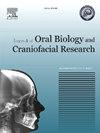Exploring the biological activity and setting dynamics of a novel polydopamine-based root repair material
Q1 Medicine
Journal of oral biology and craniofacial research
Pub Date : 2025-04-29
DOI:10.1016/j.jobcr.2025.04.001
引用次数: 0
Abstract
Background
Root perforation represents a significant complication in endodontics, compromising the structural integrity of the tooth. Effective repair are critical to mitigating the associated risks and preserving long-term dental function. Despite extensive research, the ideal repair material that fulfills all requisite biological and mechanical properties remains elusive.
Methodology
This study introduces a novel polydopamine based repair material designed to address the limitations of existing materials. The material was characterized using field emission scanning electron microscopy, X-ray diffraction, Fourier-transform infrared spectroscopy, transmission electron microscopy, zeta potential, and particle size analysis. The material's initial and final setting times were evaluated using a Gilmore needle apparatus. Biocompatibility was assessed via the MTT assay, while bioactivity was quantified through calcium ion release analysis. Comparative evaluations were conducted against ProRoot MTA, a commercially available standard in root repair.
Results
The findings revealed no statistically significant differences in cytotoxicity (P > 0.05) between the experimental material and ProRoot MTA, affirming the biocompatibility of both. However, the experimental material demonstrated a significantly faster set (P < 0.001) than ProRoot MTA, a critical advantage in clinical applications. the inclusion of calcium chloride and bioactive glass enhanced calcium ion release, with the experimental material showing significantly higher levels at 7 days.
Conclusion
The polydopamine-bioactive glass composite exhibited favorable biological activity, superior setting dynamics, and enhanced bioactivity, positioning it as a promising candidate for perforation repair. These results lay the groundwork for further research and potential clinical translation, offering a viable solution to a longstanding challenge in endodontics.

探索一种新型多多巴胺基根修复材料的生物活性和设置动力学
牙根穿孔是牙髓学中一种重要的并发症,它损害了牙齿的结构完整性。有效的修复是减轻相关风险和保持长期牙齿功能的关键。尽管广泛的研究,理想的修复材料,满足所有必要的生物和机械性能仍然难以捉摸。本研究介绍了一种新型的基于聚多巴胺的修复材料,旨在解决现有材料的局限性。采用场发射扫描电镜、x射线衍射、傅里叶变换红外光谱、透射电镜、zeta电位和粒度分析对材料进行了表征。使用Gilmore针装置评估材料的初始和最终凝固时间。MTT法测定生物相容性,钙离子释放法测定生物活性。与市售的牙根修复标准prooroot MTA进行了比较评估。结果两组细胞毒性(P >;0.05),证实了两者的生物相容性。然而,实验材料显示出明显更快的集合(P <;0.001)优于prooroot MTA,这是临床应用的关键优势。氯化钙和生物活性玻璃的包合增强了钙离子的释放,实验材料在第7天显示出明显更高的水平。结论聚多巴胺-生物活性玻璃复合材料具有良好的生物活性、良好的凝固动力学和增强的生物活性,是一种有前景的穿孔修复材料。这些结果为进一步的研究和潜在的临床转化奠定了基础,为牙髓学长期面临的挑战提供了可行的解决方案。
本文章由计算机程序翻译,如有差异,请以英文原文为准。
求助全文
约1分钟内获得全文
求助全文
来源期刊

Journal of oral biology and craniofacial research
Medicine-Otorhinolaryngology
CiteScore
4.90
自引率
0.00%
发文量
133
审稿时长
167 days
期刊介绍:
Journal of Oral Biology and Craniofacial Research (JOBCR)is the official journal of the Craniofacial Research Foundation (CRF). The journal aims to provide a common platform for both clinical and translational research and to promote interdisciplinary sciences in craniofacial region. JOBCR publishes content that includes diseases, injuries and defects in the head, neck, face, jaws and the hard and soft tissues of the mouth and jaws and face region; diagnosis and medical management of diseases specific to the orofacial tissues and of oral manifestations of systemic diseases; studies on identifying populations at risk of oral disease or in need of specific care, and comparing regional, environmental, social, and access similarities and differences in dental care between populations; diseases of the mouth and related structures like salivary glands, temporomandibular joints, facial muscles and perioral skin; biomedical engineering, tissue engineering and stem cells. The journal publishes reviews, commentaries, peer-reviewed original research articles, short communication, and case reports.
 求助内容:
求助内容: 应助结果提醒方式:
应助结果提醒方式:


